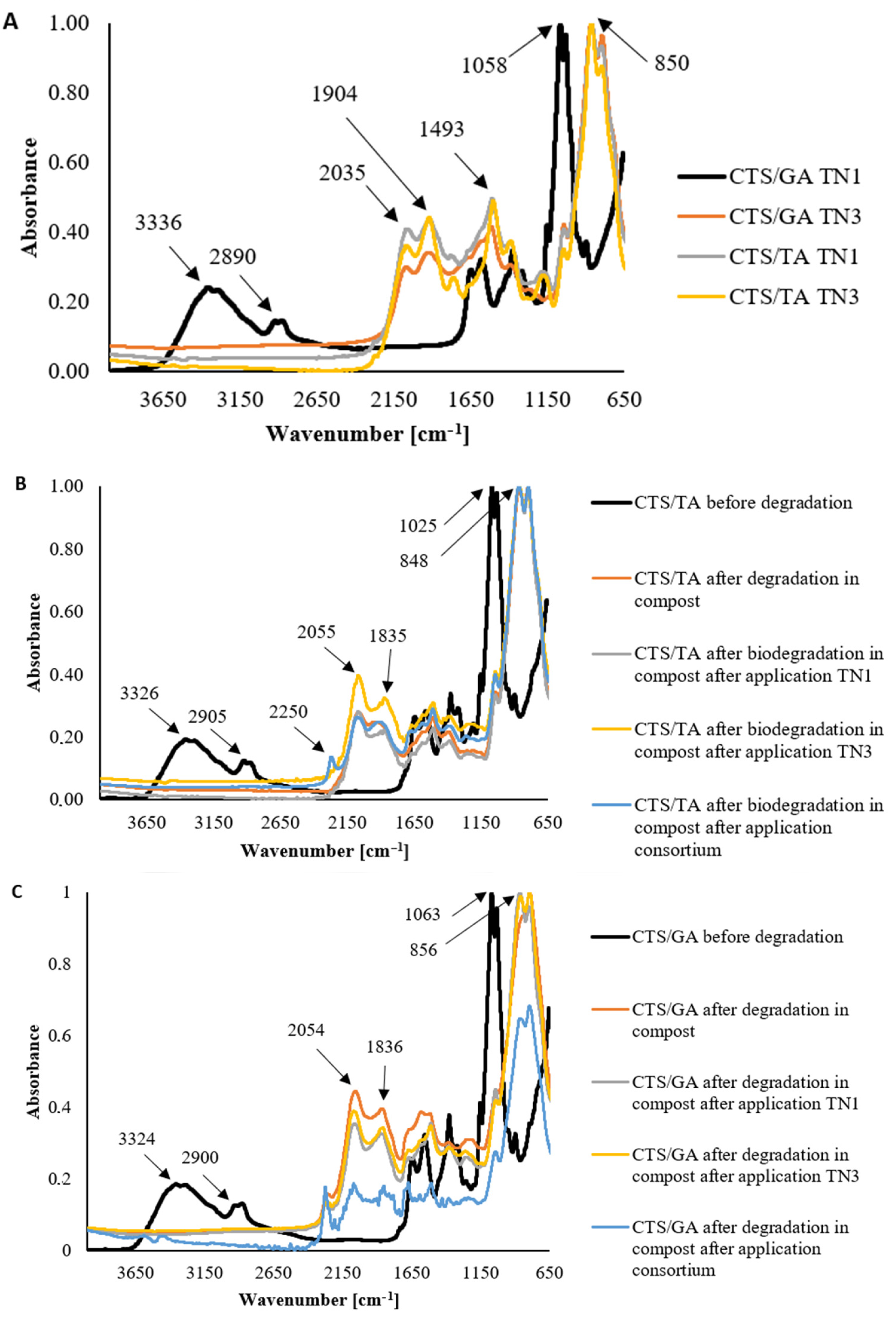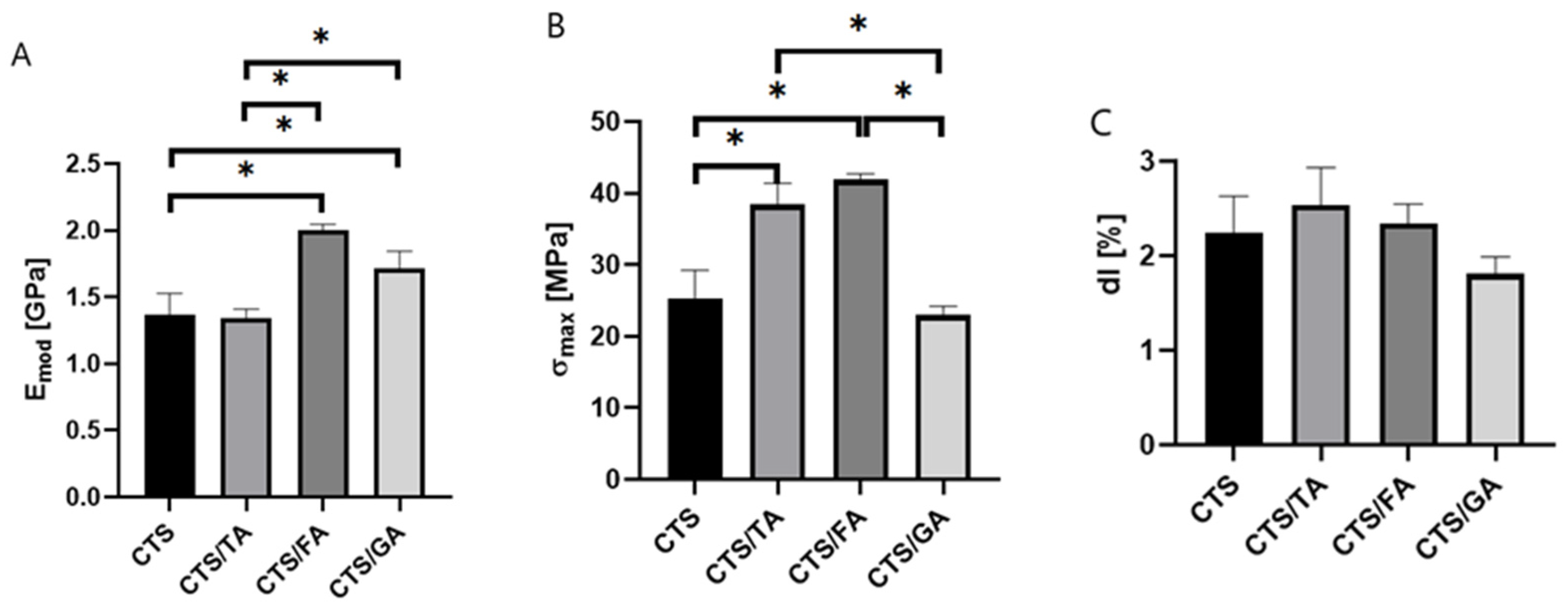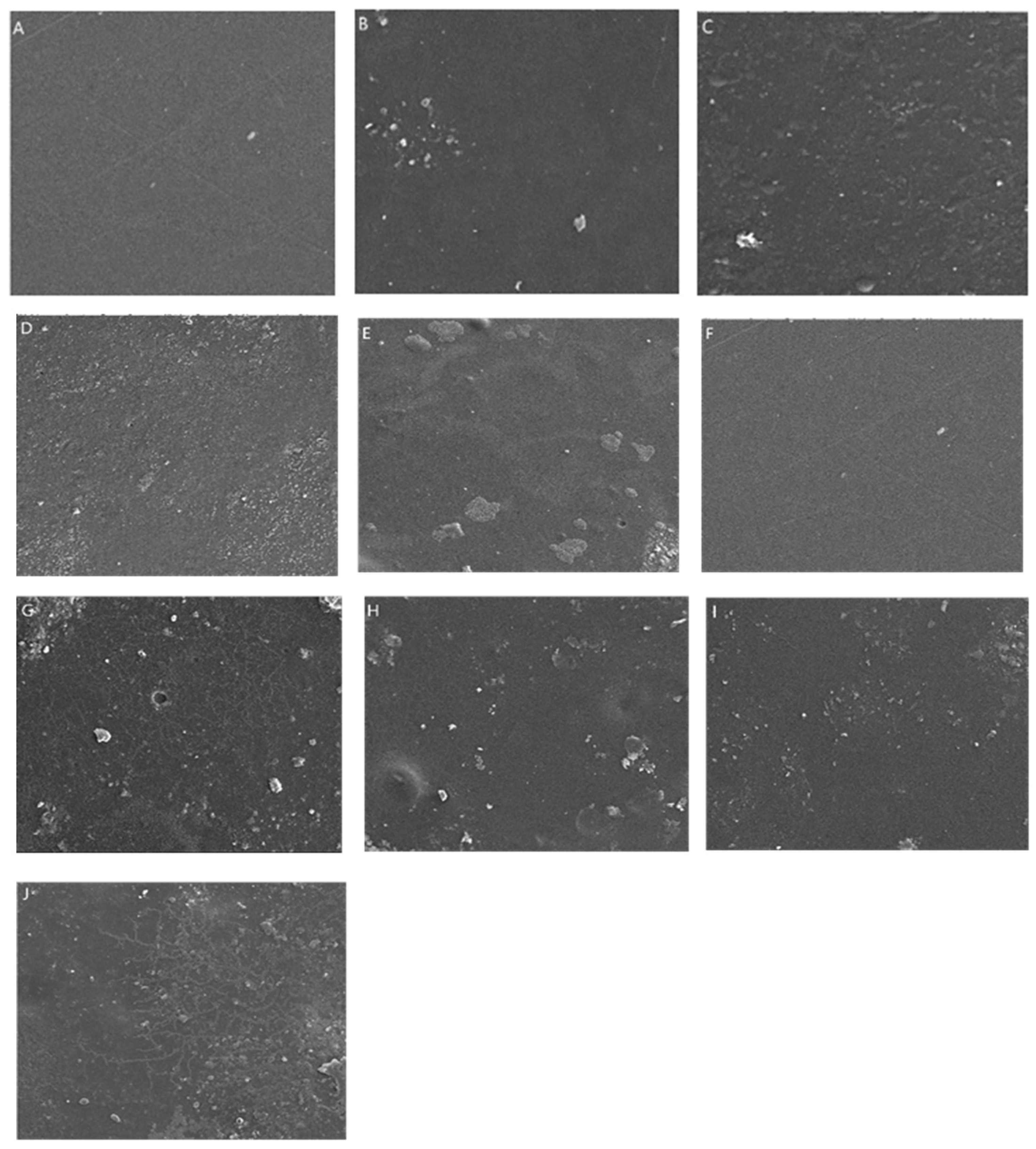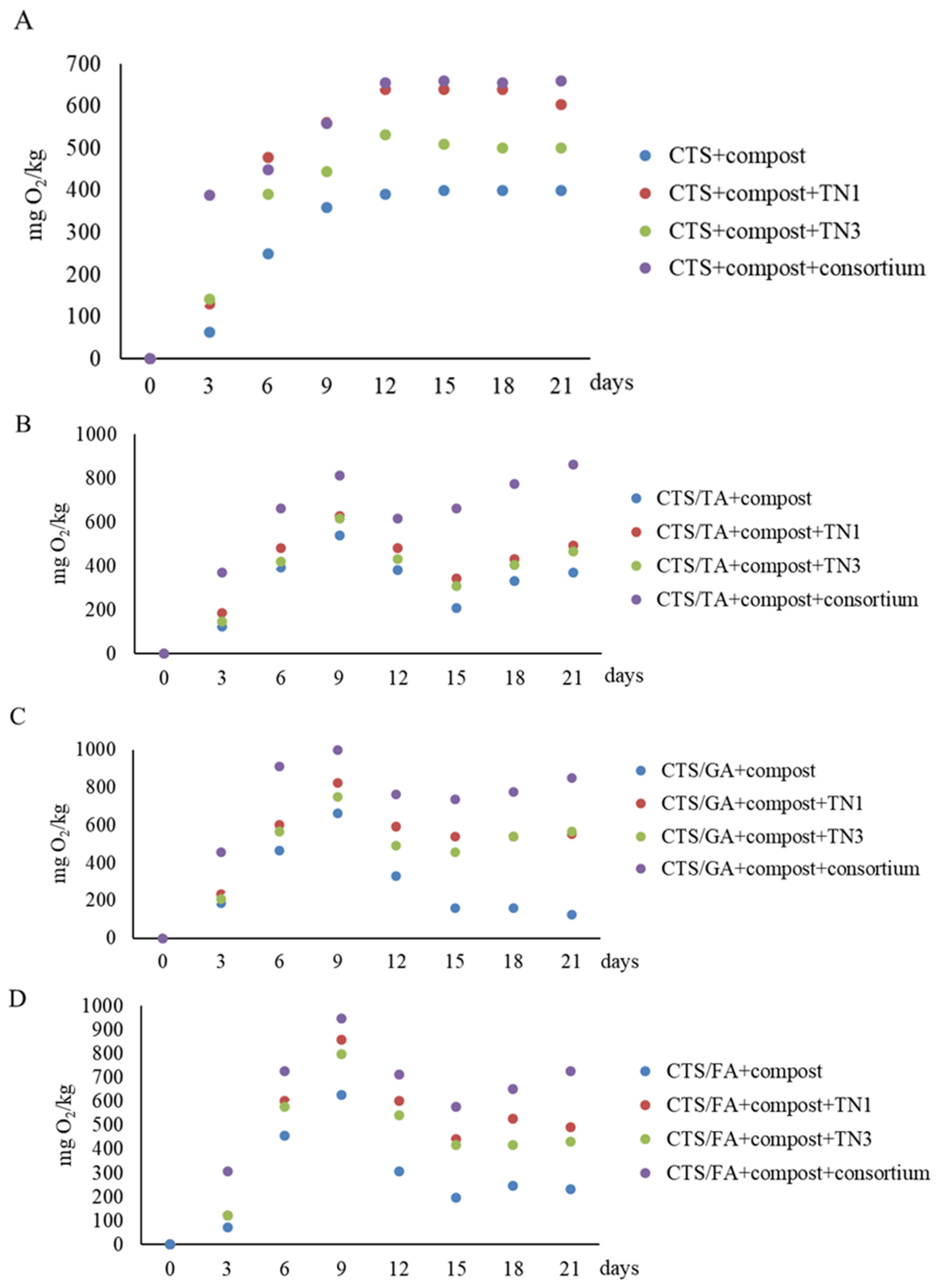Application Potential of Trichoderma in the Degradation of Phenolic Acid-Modified Chitosan
Abstract
:1. Introduction
2. Experiments
2.1. Isolation and Molecular Identification of Fungal Strains
2.2. Chitosan Films Preparation
2.3. Enzymatic Characteristics of Trichoderma
2.4. Biological Activity of Trichoderma in the Presence of Chitosan Films
2.5. Fourier Transform Infrared Spectroscopy—Attenuated Total Reflectance (FTIR–ATR)
2.6. Mechanical Properties
2.7. Scanning Electron Microscopy (SEM)
2.8. Biodegradation of Chitosan Films in the Compost after Application of Trichoderma Strains
2.9. Effect of Application of Trichoderma on Hydrolytic Enzymes Activity in Compost
2.10. Statistical Analysis
3. Results and Discussion
3.1. Molecular Identification of Trichoderma
3.2. Enzymatic Activity of Trichoderma Strains
3.3. Respirometric Activity of Trichoderma in the Presence of Modified Chitosan Films
3.4. Fourier Transform Infrared Spectroscopy—Attenuated Total Reflectance (FTIR–ATR)
3.5. Mechanical Properties
3.6. Scanning Electron Microscopy (SEM)
3.7. Biodegradation of Chitosan Films in the Compost after Application of Trichoderma
3.8. Effect of Application of Trichoderma on Hydrolytic Enzymes Activity in Compost
4. Conclusions
Supplementary Materials
Author Contributions
Funding
Data Availability Statement
Conflicts of Interest
References
- Vroman, I.; Tighzert, L. Biodegradable Polymers. Materials 2009, 2, 307–344. [Google Scholar] [CrossRef]
- Priyadarshi, R.; Rhim, J.W. Chitosan-based biodegradable functional films for food packaging applications. Innov. Food Sci. Emerg. Technol. 2020, 62, 102346. [Google Scholar] [CrossRef]
- Wang, W.; Xue, C.; Mao, X. Chitosan: Structural modification, biological activity and application. Int. J. Biol. Macromol. 2020, 164, 4532–4546. [Google Scholar] [CrossRef] [PubMed]
- Kaczmarek-Szczepańska, B.; Michalska-Sionkowska, M.; Mazur, O.; Świątczak, J.; Swiontek Brzezinska, M. The role of microorganisms in biodegradation of chitosan/tannic acid materials. Int. J. Biol. Macromol. 2021, 184, 584–592. [Google Scholar] [CrossRef] [PubMed]
- Borges, A.; Ferreira, C.; Saavedra, M.J.; Simões, M. Antibacterial activity and mode of action of ferulic and gallic acids against pathogenic bacteria. Microb. Drug Resist. 2013, 19, 256–265. [Google Scholar] [CrossRef]
- Kaczmarek-Szczepańska, B.; Wekwejt, M.; Mazur, O.; Zasada, L.; Pałubicka, A.; Olewnik-Kruszkowska, E. The physicochemical and antibacterial properties of chitosan-based materials modified with phenolic acids irradiated by UVC light. Int. J. Mol. Sci. 2021, 22, 6472. [Google Scholar] [CrossRef]
- Richert, A.; Olewnik-Kruszkowska, E.; Dąbrowska, G.B.; Dąbrowski, H.P. The Role of Birch Tar in Changing the Physicochemical and Biocidal Properties of Polylactide-Based Films. Int. J. Mol. Sci. 2022, 23, 268. [Google Scholar] [CrossRef]
- Richert, A.; Kalwasińska, A.; Jankiewicz, U.; Swiontek Brzezinska, M. Effect of birch tar embedded in polylactide on its biodegradation. Int. J. Biol. Macromol. 2023, 239, 124226. [Google Scholar] [CrossRef]
- Janczak, K.; Dąbrowska, G.B.; Raszkowska-Kaczor, A.; Kaczor, D.; Hrynkiewicz, K.; Richert, A. Biodegradation of the plastics PLA and PET in cultivated soil with the participation of microorganisms and plants. Int. Biodeterior. Biodegrad. 2020, 155, 1050. [Google Scholar] [CrossRef]
- Richert, A.; Dąbrowska, G.B. Bacterial biofilm on PLA films and methods of its identification. Ecol. Quest. 2020, 31, 31–38. [Google Scholar] [CrossRef]
- Dąbrowska, G.B.; Garstecka, Z.; Olewnik-Kruszkowska, E.; Szczepańska, G.; Ostrowski, M.; Mierek-Adamska, A. Comparative study of structural changes of polylactide and poly(ethylene terephthalate) in the presence of Trichoderma viride. Int. J. Mol. Sci. 2021, 22, 3491. [Google Scholar] [CrossRef] [PubMed]
- Richert, A.; Dąbrowska, G.B. Enzymatic degradation and biofilm formation during biodegradation of polylactide and polycaprolactone polymers in various environments. Int. J. Biol. Macromol. 2021, 176, 226–232. [Google Scholar] [CrossRef] [PubMed]
- Abdel-Motaal, F.F.; El-Sayed, M.A.; El-Zayat, S.A.; Ito, S.I. Biodegradation of poly (-caprolactone) (PCL) film and foam plastic by Pseudozyma japonica sp. nov., a novel cutinolytic ustilaginomycetous yeast species. 3 Biotech 2014, 4, 507–512. [Google Scholar] [CrossRef] [PubMed]
- Znajewska, Z.; Dąbrowska, G.B.; Hrynkiewicz, K.; Janczak, K. Biodegradation of polycaprolactone by Trichoderma viride fungi. Chem. Ind. 2018, 97, 1676–1679. [Google Scholar] [CrossRef]
- Kannahi, M.; Thamizhmarai, T. Biodegradation of plastic by Aspergillus sp. Int. J. Trend Sci. Res. Dev. 2018, 2, 683–690. [Google Scholar] [CrossRef]
- Vivi, V.K.; Martins-Franchetti, S.M.; Attili-Angelis, D. Biodegradation of PCL and PVC: Chaetomium globosum (ATCC 16021) activity. Folia Microbiol. 2019, 64, 1–7. [Google Scholar] [CrossRef] [PubMed]
- Ohkawa, K.; Yamada, M.; Nishida, A.; Nishi, N.; Yamamoto, H. Biodegradation of chitosan-gellan and poly (L-lysine)-gellan polyion complex fibers by pure cultures of soil filamentous fungi. J. Polym. Environ. 2000, 8, 59–66. [Google Scholar] [CrossRef]
- Znajewska, Z.; Dąbrowska, G.B.; Narbutt, O. Trichoderma viride stains stimulating the growth and development of winter rapeseed (Brassica napus L.). Prog. Plant Prot. 2018, 58, 264–269. [Google Scholar] [CrossRef]
- Harman, G.E.; Howell, C.R.; Viterbo, A.; Chet, I.; Lorito, M. Trichoderma species—Opportunistic, avirulent plant symbionts. Nat. Rev. Microbiol. 2004, 2, 43–56. [Google Scholar] [CrossRef]
- Janczak, K.; Dąbrowska, G.; Znajewska, Z.; Hrynkiewicz, K. Searching for the fungi capable to grow on polymeric materials. Przemysł Chem. 2014, 93, 1206–1209. [Google Scholar] [CrossRef]
- Kaczmarek-Szczepańska, B.; Polkowska, I.; Paździor-Czapula, K.; Nowicka, B.; Gierszewska, M.; Michalska-Sionkowska, M.; Otrocka-Domagała, I. Chitosan/Phenolic Compounds Scaffolds for Connective Tissue Regeneration. J. Funct. Biomater. 2023, 14, 69. [Google Scholar] [CrossRef] [PubMed]
- Vancov, T.; Keen, B. Amplification of soil fungal community DNA using the ITS86F and ITS4 primers. FEMS Microbiol. Lett. 2009, 296, 91–96. [Google Scholar] [CrossRef] [PubMed]
- Raja, H.A.; Miller, A.N.; Pearce, C.J.; Oberlies, N.H. Fungal identification using molecular tools: A primer from the natural products research community. J. Nat. Prod. 2017, 80, 756–770. [Google Scholar] [CrossRef] [PubMed]
- Hoppe, H.G. Significance of exoenzymatic activities in the ecology of brackish water: Measurements by means of methylumbelliferyl-substrates. Mar. Ecol. Prog. Ser. 1983, 11, 299–308. [Google Scholar] [CrossRef]
- Freeman, C.; Liska, G.; Ostle, N.J.; Jones, S.E.; Lock, M.A. The use of fluorogenic substrates for measuring enzyme activity in peatlands. Plant Soil 1995, 175, 147–152. [Google Scholar] [CrossRef]
- Niemi, R.M.; Vepsäläinen, M. Stability of the fluorogenic enzyme substrates and pH optima of enzyme activities in different Finnish soils. J. Microbiol. Methods 2005, 60, 195–205. [Google Scholar] [CrossRef] [PubMed]
- Wu, Q.; Dou, X.; Wang, Q.; Guan, Z.; Cai, Y.; Liao, X. Isolation of β-1,3-Glucanase-Producing Microorganisms from Poria cocos Cultivation Soil via Molecular Biology. Molecules 2018, 23, 1555. [Google Scholar] [CrossRef]
- Swiontek Brzezinska, M.; Jankiewicz, U.; Walczak, M. Biodegradation of chitinous substances and chitinase production by the soil actinomycete Streptomyces rimosus. Int. Biodeterior. Biodegrad. 2013, 84, 104–110. [Google Scholar] [CrossRef]
- Swiontek Brzezinska, M.; Richert, A.; Kalwasińska, A.; Świątczak, J.; Deja-Sikora, E.; Walczak, M.; Michalska-Sionkowska, M.; Piekarska, K.; Kaczmarek-Szczepańska, B. Microbial degradation of polyhydroxybutarate with embedded polyhexamethylene guanidine derivatives. Int. J. Biol. Macromol. 2021, 187, 309–318. [Google Scholar] [CrossRef]
- Bednarek, R.; Dziadowiec, H.; Pokojska, U.; Prusinkiewicz, Z. Badania Ekologiczno-Gleboznawcze; Wydawnictwo Naukowe PWN: Warszawa, Poland, 2004; ISBN 83-01-14216-2. [Google Scholar]
- PN-ISO 14235; Determination of Organic Carbon Content by Oxidation With Dichromate (VI) in Sulphuric Acid Medium. Polish Committee for Standardisation: Warsaw, Poland, 2003. (In Polish)
- PN-R-04022; Chemical and Agricultural Analysis of Soil—Determination of Available Potassium in Mineral Soils. Polish Committee for Standardisation: Warsaw, Poland, 1996. (In Polish)
- PN-R-04028; Soil Chemical and Agricultural Analysis, Sampling and Determination of Nitrogen and Ammonium Ions in Mineral Soils. Polish Committee for Standardisation: Warsaw, Poland, 1997. (In Polish)
- PN-R-04022:1996/Az1; Soil Chemical and Agricultural Analysis -Determination of Available Potassium in Mineral Soils. Polish Committee for Standardisation: Warsaw, Poland, 2002. (In Polish)
- PN-R-04020:1994/Az1; Chemical and Agricultural Analysis of Soil—Determination of Available Magnesium Content. Polish Committee for Standardisation: Warsaw, Poland, 2004. (In Polish)
- Platen, H.; Wirtz, A. The measurement of respiration activity soil with a respirometric method (measuring system Oxi Top Control). In WTW/OxiTopR/Appliance; Fachbereich KMUB, Umwelt-und Hygienetechnik und Zentrum f¸r Umwelttechnologie: Giessen, Germany, 1999. [Google Scholar]
- Adam, G.; Duncan, H. Development of a sensitive and rapid method for the measurement of total microbial activity using fluorescein diacetate (FDA) in a range of soils. Soil Biol. Biochem. 2001, 33, 943–951. [Google Scholar] [CrossRef]
- Hammer, Ř.; Harper, D.A.T.; Ryan, P.D. PAST: Paleontological Statistics Software Package for Education and Data Analysis. Palaeontol. Electron. 2001, 4, 9. [Google Scholar]
- Savitha, M.J.; Sriram, S. Morphological and molecular identification of Trichoderma isolates with biocontrol potential against Phytophthora blight in red pepper. Pest Manag. Hortic. Ecosyst. 2015, 21, 194–202. [Google Scholar]
- Soesanto, L.; Sri-Utami, D.; Rahayuniati, R.F. Morphological characteristics of four Trichoderma isolates and two endophytic Fusarium isolates. Can. J. Sci. Ind. Res. 2011, 2, 294–306. [Google Scholar]
- Choi, I.-Y.; Hong, S.-B.; Yadav, M.C. Molecular and morphological characterization of green mold, Trichoderma spp. isolated from oyster mushrooms. Mycobiology 2003, 31, 74–80. [Google Scholar] [CrossRef]
- Narayan, K.; Kotasthane, A. Genetic relatedness among Trichoderma isolates inhibiting a pathogenic fungi Rhizoctonia solani. J. Biotechnol. 2006, 5, 580–584. [Google Scholar]
- Lücking, R.; Aime, M.C.; Robbertse, B.; Miller, A.N.; Ariyawansa, H.A.; Aoki, T.; Cardinali, G.; Crous, P.W.; Druzhinina, I.S.; Geiser, D.M.; et al. Unambiguous identification of fungi: Where do we stand and how accurate and precise is fungal DNA barcoding? IMA Fungus 2020, 11, 14. [Google Scholar] [CrossRef] [PubMed]
- Contreras-Cornejo, H.A.; López-Bucio, J.S.; Méndez-Bravo, A.; Macías-Rodríguez, L.; Ramos-Vega, M.; Guevara-García, A.A.; López-Bucio, J. Mitogen-Activated Protein Kinase 6 and Ethylene and Auxin Signaling Pathways Are Involved in Arabidopsis Root-System Architecture Alterations by Trichoderma atroviride. Mol. Plant Microbe Interact. 2015, 28, 701–710. [Google Scholar] [CrossRef]
- Cherkupally, R.; Amballa, H.; Bhoomi, N.R. In vitro screening for enzymatic activity of Trichoderma species for biocontrol potential. Ann. Plant Sci. 2017, 6, 1784–1789. [Google Scholar] [CrossRef]
- Xia, W.; Liu, P.; Liu, J. Advance in chitosan hydrolysis by non-specific cellulases. Bioresour. Technol. 2008, 99, 6751–6762. [Google Scholar] [CrossRef]
- Win, T.T.; Bo, B.; Malec, P.; Khan, S.; Fu, P. Newly isolated strain of Trichoderma asperellum from disease suppressive soil is a potential bio-control agent to suppress Fusarium soil borne fungal phytopathogens. J. Plant Pathol. 2021, 103, 549–561. [Google Scholar] [CrossRef]
- Gruber, S.; Seidl-Seiboth, V. Self versus non-self: Fungal cell wall degradation in Trichoderma. Microbiology 2021, 158, 26–34. [Google Scholar] [CrossRef] [PubMed]
- Vázquez, M.B.; Barrera, V.; Bianchinotti, V. Molecular identification of three isolates of Trichoderma harzianum isolated from agricultural soils in Argentina, and their abilities to detoxify in vitro metsulfuron methyl. Botany 2015, 93, 793–800. [Google Scholar] [CrossRef]
- Abdenaceur, R.; Farida, B.T.; Mourad, D.; Rima, H.; Zahia, O.; Fatma, S.H. Effective biofertilizer Trichoderma spp. isolates with enzymatic activity and metabolites enhancing plant growth. Int. Microbiol. 2022, 25, 817–829. [Google Scholar] [CrossRef]
- Wang, Y.; Ma, R.; Li, S.; Gong, M.; Yao, B.; Bai, Y.; Gu, J. An alkaline and surfactant-tolerant lipase from Trichoderma lentiforme ACCC30425 with high application potential in the detergent industry. AMB Expres 2018, 8, 95. [Google Scholar] [CrossRef] [PubMed]
- Qian, Y.; Zhong, L.; Sun, Y.; Sun, N.; Zhang, L.; Liu, W.; Zhong, Y. Enhancement of cellulase production in Trichoderma reesei via disruption of multiple protease genes identified by comparative secretomics. Front. Microbiol. 2019, 10, 2784. [Google Scholar] [CrossRef]
- Deng, J.J.; Huang, W.Q.; Li, Z.W.; Lu, D.L.; Zhang, Y.; Luo, X.C. Biocontrol activity of recombinant aspartic protease from Trichoderma harzianum against pathogenic fungi. Enzym. Microb. Technol. 2018, 112, 35–42. [Google Scholar] [CrossRef] [PubMed]
- Aranaz, I.; Mengibar, M.; Harris, R.; Panos, I.; Miralles, B.; Acosta, N.; Gemma, G.; Heras, A. Functional characterization of chitin and chitosan. Curr. Chem. Biol. 2009, 3, 203–230. [Google Scholar] [CrossRef]
- Islam, S.; Bhuiyan, M.R.; Islam, M.N. Chitin and chitosan: Structure, properties and applications in biomedical engineering. J. Polym. Environ. 2017, 25, 854–866. [Google Scholar] [CrossRef]
- Klaykruayat, B.; Siralertmukul, K.; Srikulkit, K. Chemical modification of chitosan with cationic hyperbranched dendritic polyamidoamine and its antimicrobial activity on cotton fabric. Carbohydr. Polym. 2010, 80, 197–207. [Google Scholar] [CrossRef]
- Babaee, M.; Garavand, F.; Rehman, A.; Jafarazadeh, S.; Amini, E.; Cacciotti, I. Biodegradability, physical, mechanical and antimicrobial attributes of starch nanocomposites containing chitosan nanoparticles. Int. J. Biol. Macromol. 2022, 195, 49–58. [Google Scholar] [CrossRef]
- Stoleru, E.; Hitruc, E.G.; Vasile, C.; Oprică, L. Biodegradation of poly (lactic acid)/chitosan stratified composites in presence of the Phanerochaete chrysosporium fungus. Polym. Degrad. Stab. 2017, 143, 118–129. [Google Scholar] [CrossRef]
- Mathew, S.; Abraham, T.E. Characterisation of ferulic acid incorporated starch–chitosan blend films. Food Hydrocoll. 2008, 22, 826–835. [Google Scholar] [CrossRef]
- Rui, L.; Xie, M.; Hu, B.; Zhou, L.; Yin, D.; Zeng, X. A comparative study on chitosan/gelatin composite films with conjugated or incorporated gallic acid. Carbohydr. Polym. 2017, 173, 473–481. [Google Scholar] [CrossRef]
- Qin, Z.; Huang, Y.; Xiao, S.; Zhang, H.; Lu, Y.; Xu, K. Preparation and characterization of high mechanical strength chitosan/oxidized tannic acid composite film with Schiff base and hydrogen bond crosslinking. Int. J. Mol. Sci. 2022, 23, 9284. [Google Scholar] [CrossRef] [PubMed]
- Sun, X.; Wang, Z.; Kadouh, H.; Zhou, K. The antimicrobial, mechanical, physical and structural properties of chitosan–gallic acid films. LWT-Food Sci. Technol. 2014, 57, 83–89. [Google Scholar] [CrossRef]
- Rivero, S.; Garcia, M.A.; Pinotti, A. Physical and chemical treatments on chitosan matrix to modify film properties and kinetics of biodegradation. J. Mater. Phys. Chem. 2013, 1, 51–57. [Google Scholar]
- Poorna Chandrika, K.S.V.; Prasad, R.D.; Godbole, V. Development of chitosan-PEG blended films using Trichoderma: Enhancement of antimicrobial activity and seed quality. Int. J. Biol. Macromol. 2019, 126, 282–290. [Google Scholar] [CrossRef] [PubMed]
- Cheng, M.; Wang, J.; Zhang, R.; Kong, R.; Lu, W.; Wang, X. Characterization and application of the microencapsulated carvacrol/sodium alginate films as food packaging materials. Int. J. Biol. Macromol. 2019, 141, 259–267. [Google Scholar] [CrossRef]
- Altun, E.; Çelik, E.; Ersan, H.Y. Tailoring the microbial community for improving the biodegradation of chitosan films in composting environment. J. Polym. Environ. 2020, 28, 1548–1559. [Google Scholar] [CrossRef]
- Ahmad, R.; Jilan, G.; Arshad, M.; Zahir, Z.A.; Khalid, A. Bio-conversion of organic wastes for their recycling in agriculture: An overview of perspectives and prospects. Ann. Microbiol. 2007, 57, 471–479. [Google Scholar] [CrossRef]
- Klose, S.; Acosta-Martínez, V.; Ajwa, H.A. Microbial community composition and enzyme activities in a sandy loam soil after fumigation with methyl bromide or alternative biocides. Soil Biol. Biochem. 2006, 38, 1243–1254. [Google Scholar] [CrossRef]
- Su, S.; Zeng, X.; Bai, L.; Williams, P.N.; Wang, Y.; Zhang, L.; Wu, C. Inoculating chlamydospores of Trichoderma asperellum SM-12F1 changes arsenic availability and enzyme activity in soils and improves water spinach growth. Chemosphere 2017, 175, 497–504. [Google Scholar] [CrossRef] [PubMed]
- Yedidia, I.; Benhamou, N.; Kapulnik, Y.; Chet, I. Induction and accumulation of PR proteins activityduring early stages of root colonizationby the mycoparasite Trichoderma harzianum strain T-203. Plant Physiol. Biochem. 2000, 38, 863–873. [Google Scholar] [CrossRef]
- Henry, H.A. Reprint of “Soil extracellular enzyme dynamics in a changing climate”. Soil Biol. Biochem. 2013, 56, 53–59. [Google Scholar] [CrossRef]
- García-Ruiz, R.; Ochoa, V.; Vinegla, B.; Hinojosa, M.B.; Pena-Santiago, R.; Liébanas, G.; Linares, J.C.; Carreira, J.A. Soil enzymes, nematode community and selected physico-chemical properties as soil quality indicators in organic and conventional olive oil farming: Influence of seasonality and site features. Appl. Soil Ecol. 2009, 41, 305–314. [Google Scholar] [CrossRef]
- Burke, D.J.; Weintraub, M.N.; Hewins, C.R.; Kalisz, S. Relationship between soil enzyme activities, nutrient cycling and soil fungal communities in a northern hardwood forest. Soil Biol. Biochem. 2011, 43, 795–803. [Google Scholar] [CrossRef]





| Parameters | Values |
|---|---|
| pH | 7.5 |
| humidity | 200 mbar/hPa |
| TOC (g/kg) | 351 |
| TN (g/kg) | 27 |
| N-NH4 (mg/kg) | 2.72 |
| N-NO3 (mg/kg) | 29.0 |
| P2O5 (mg/100 g) | 26.2 |
| Mg (mg/100 g) | 7.1 |
| K2O (mg/100 g) | 27.5 |
| BOD5 (mgO2/kg) | 80 |
| Hydrolase activity (mg/kg) | 14 |
| Heterotrophic bacteria numbers (CFU/g) | 45 × 105 |
| Actinomycete numbers (CFU/g) | 39 × 104 |
| Mold numbers (CFU/g) | 23 × 103 |
| Enzymes Activity (U/h) | Trichoderma artoviride TN1 | Trichoderma artoviride TN2 | Trichoderma citrinoviride TN3 |
|---|---|---|---|
| chitinase | 0.82 ± 0.03 a | 0.4 ± 0.03 c | 0.70 ± 0.04 b |
| β—1,3—glucanase | 1.63 ± 0.02 a | 0.7± 0.02 b | 1.9 ± 0.01 a |
| lipase | 2.23 ± 0.01 a | 0.51 ± 0.20 c | 1.99 ± 0.06 b |
| α-glucosidase | 0.08 ± 0.01 a | 0.06 ± 0.01 b | 0.08 ± 0.04 a |
| β-glucosidse | 0.05 ± 0.01 b | 0.02 ± 0.01 c | 0.09 ± 0.02 a |
| aminopeptidase | 1.7 ± 0.02 b | 1.9 ± 0.01 a | 1.8 ± 0.01 a |
| Materials | Trichoderma artoviride TN1 | Trichoderma artoviride TN2 | Trichoderma citrinoviride TN3 |
|---|---|---|---|
| CTS | * 137 ± 2.2 a | 89 ± 3.3 a | 110 ± 2.5 a |
| CTS/TA | 210 ± 3.1 b | 120 ± 3.4 b | 178 ± 3.2 b |
| CTS/GA | 104 ± 4.0 a | 98 ± 1.3 a | 117 ± 3.3 a |
| CTS/FA | 257 ± 4.2 c | 130 ± 3.2 b | 220 ± 4.1 c |
| Sample | Thickness [mm] | Sample | Thickness [mm] |
|---|---|---|---|
| CTS | 0.090 ± 0.009 | CTS/TA after degradation in compost | 1.073 ± 0.011 a,b |
| CTS/TA | 0.131 ± 0.008 a | CTS/TA after degradation in compost after application TN1 | 1.038 ± 0.017 a,b |
| CTS/FA | 0.100 ± 0.010 | CTS/TA after degradation in compost after application TN3 | 1.098 ± 0.010 a,b |
| CTS/GA | 0.080 ± 0.006 | CTS/TA after degradation in compost after application consortium | 1.671 ± 0.013 a,b |
| CTS/GA after degradation in compost | 1.011 ± 0.008 c | ||
| CTS/GA after degradation in compost after application TN1 | 1.045 ± 0.014 c | ||
| CTS/GA after degradation in compost after application TN3 | 1.024 ± 0.009 c | ||
| CTS/GA after degradation in compost after application consortium | 1.781 ± 0.018 c |
| Sum of Squares | df | Mean Square | F | p-Value | |
|---|---|---|---|---|---|
| Phenolic substance | 4.48 × 104 | 3 | 1.49 × 104 | 1.25 × 103 | 3.32 × 10−33 |
| Variant | 1.46 × 106 | 3 | 4.88 × 105 | 4.08 × 104 | 2.24 × 10−57 |
| Interaction | 2.46 × 105 | 9 | 2.74 × 104 | 2.29 × 103 | 2.55 × 10−42 |
| Within | 3.83 × 102 | 32 | 1.20 × 101 | ||
| Total | 1.76 × 106 | 47 |
| Variants | Enzyme Activity (U/h) | ||||
|---|---|---|---|---|---|
| Chit. | Lip. | α-Gluc. | β-Gluc | Amino. | |
| Compost | 4.4 ±0.14 a | 19.4 ± 0.1 a | 4.2 ±0.13 a | 4.2 ± 0.03 a | 8.2 ± 0.05 a |
| CTS/TA + compost | 3.1 ± 0.03 b | 15.6 ± 0.01 b | 4.5 ± 0.01 a | 4.5 ± 0.01 a | 6.8 ± 0.05 b |
| CTS/TA + compost + TN1 | 5.8 ± 0.07 c | 16.8 ± 0.10 b | 4.5 ± 0.01 a | 4.3 ± 0.03 a | 9.2 ± 0.06 c |
| CTS/TA + compost + TN3 | 5.3 ± 0.06 c | 17.9 ± 0.07 b | 4.4 ± 0.01 a | 3.9 ± 0.03 a | 9.6 ± 0.02 c |
| CTS + compost + TN1 + TN3 | 5.8 ± 0.21 c | 34.2 ± 0.31 c | 4.6 ± 0.41 a | 4.2 ± 0.02 a | 9.4 ± 0.06 c |
| CTS/GA + compost | 4.0 ± 0.18 a | 7.0 ± 0.05 b | 3.6 ± 0.01 a | 4.1 ± 0.01 a | 1.3 ± 0,03 b |
| CTS/GA + compost + TN1 | 5.5 ± 0.01 a | 13.2 ± 0.12 c | 3.7 ± 0.01 a | 4.2 ± 0.02 a | 5.8 ± 0.01 c |
| CTS/GA + compost + TN3 | 6.6 ± 0.03 b | 13.4 ± 0.01 c | 3.0 ± 0.01 a | 4.3 ± 0.02 a | 6.2 ± 0.01 c |
| CTS/GA + compost + TN1 + TN3 | 11.2 ± 0.12 c | 13.6 ± 0.01 c | 3.0 ± 0.01 a | 3.9 ± 0.01 a | 5.4 ± 0.05 c |
| CTS/FA + compost | 3.9 ± 0.28 a | 19.9 ± 0.08 a | 4.7 ± 0.01 a | 4.2 ± 0.08 a | 3.7 ± 0.02 b |
| CTS/FA + compost + TN1 | 25 ± 0.11 b | 14.0 ± 0.04 b | 4.8 ± 0.01 b | 4.4 ± 0.01 a | 7.4 ± 0.03 c |
| CTS/FA + compost + TN3 | 28.3 ± 0.28 b | 23.3 ± 0.01 b | 4.6 ± 0.03 b | 4.9 ± 0.01 a | 6.5 ± 0.03 c |
| CTS/FA + compost + N1 + TN3 | 38.5 ± 0.57 c | 25.1 ± 0.01 b | 4.3 ± 0.02 b | 4.6 ± 0.01 a | 6.1 ± 0.06 c |
Disclaimer/Publisher’s Note: The statements, opinions and data contained in all publications are solely those of the individual author(s) and contributor(s) and not of MDPI and/or the editor(s). MDPI and/or the editor(s) disclaim responsibility for any injury to people or property resulting from any ideas, methods, instructions or products referred to in the content. |
© 2023 by the authors. Licensee MDPI, Basel, Switzerland. This article is an open access article distributed under the terms and conditions of the Creative Commons Attribution (CC BY) license (https://creativecommons.org/licenses/by/4.0/).
Share and Cite
Swiontek Brzezinska, M.; Kaczmarek-Szczepańska, B.; Dąbrowska, G.B.; Michalska-Sionkowska, M.; Dembińska, K.; Richert, A.; Pejchalová, M.; Kumar, S.B.; Kalwasińska, A. Application Potential of Trichoderma in the Degradation of Phenolic Acid-Modified Chitosan. Foods 2023, 12, 3669. https://doi.org/10.3390/foods12193669
Swiontek Brzezinska M, Kaczmarek-Szczepańska B, Dąbrowska GB, Michalska-Sionkowska M, Dembińska K, Richert A, Pejchalová M, Kumar SB, Kalwasińska A. Application Potential of Trichoderma in the Degradation of Phenolic Acid-Modified Chitosan. Foods. 2023; 12(19):3669. https://doi.org/10.3390/foods12193669
Chicago/Turabian StyleSwiontek Brzezinska, Maria, Beata Kaczmarek-Szczepańska, Grażyna B. Dąbrowska, Marta Michalska-Sionkowska, Katarzyna Dembińska, Agnieszka Richert, Marcela Pejchalová, Sweta Binod Kumar, and Agnieszka Kalwasińska. 2023. "Application Potential of Trichoderma in the Degradation of Phenolic Acid-Modified Chitosan" Foods 12, no. 19: 3669. https://doi.org/10.3390/foods12193669









